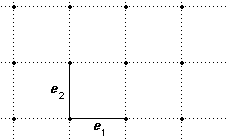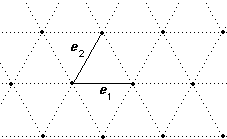Course MT3818 Topics in Geometry
Lattices
This is the study of discrete subgroups of I(Rn). We shall mainly look at the case n = 2.
Our aim is to classify the two-dimensional crystallographic groups in much the same way as we classified the Frieze groups.
In the case of the frieze groups, we took a "smallest translation" and looked at what happened when we applied this to a point. (This is called the orbit of the point.) This gave us a subset of R which we might as well take to be the additive subgroup Z.
We now do something rather similar in R2.
Definition
A lattice L is a discrete subgroup of the group Rn (under addition).
Remarks
- We will usually assume that L does not lie in a lower-dimensional subspace of Rn.
- Recall that discrete means that there is a minimum distance between points of L.
- We will usually think of L as a subgroup of the group of translations in I(Rn).
One can get a basis for a lattice as follows.
Choose e1 to be the closest vector in L to 0. Then all the vectors in span(e1) are integer multiples of e1 .
Then choose a vector e2 not in span(e1) but closest to it. Then every vector in span(e1 , e2) is of the form a1e1 + a2e2 with a1 , a2 ∈ Z.
Continuing we get:
Alternative definition
A lattice L is the set {a1e1 + a2e2 + ... + anen | ai ∈ Z } where {e1 , ... , en } is a basis of the vector space Rn.
Remark
Note that the basis constructed above is not the only possible basis.
Examples
- In R the only lattice is essentially Z.
 A general lattice in R2
A general lattice in R2
For this lattice we choose e1 and e2 with no special connections between the lengths or angles of the vectors.
 A rectangular lattice in R2
A rectangular lattice in R2
We may choose a basis in which e1 and e2 are perpendicular
 A square lattice in R2
A square lattice in R2
A rectangular lattice in which ‖e1‖ = ‖e2‖
- A rhomboidal or isosceles or centred lattice in R2


We have ‖e1‖ = ‖e2‖ but e1 and e2 are not necessarily perpendicular
 A hexagonal or equilateral lattice in R2
A hexagonal or equilateral lattice in R2
A lattice in which ‖e1‖ = ‖e2‖ and the angle beween e1 and e2 is π/3.
 A non-lattice in R2
A non-lattice in R2
- A simple cubic lattice in R3
- A body centred cubic lattice in R3
- A face centred cubic lattice in R3
Crystallographers classify lattices in R3 into 14 different types. They all appear in the structures of various chemical compounds.
JOC March 2003
 A general lattice in R2
A general lattice in R2 A rectangular lattice in R2
A rectangular lattice in R2 A square lattice in R2
A square lattice in R2

 A hexagonal or equilateral lattice in R2
A hexagonal or equilateral lattice in R2 A non-lattice in R2
A non-lattice in R2